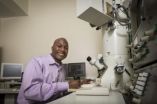(Press-News.org) Scientists have gained new insights into the molecular process of how some people get type II diabetes, which could lead to new ways of preventing people from getting the condition.
The research, led by the University of Southampton and UCL, which took place on Mount Everest, assessed the mechanisms by which low oxygen levels in the body – known as hypoxia – are associated with the development of insulin resistance.
Insulin resistance is when cells fail to respond to insulin in the body. Insulin enables the body to regulate sugar levels. Too much sugar can be toxic and leads to type II diabetes.
The research, published in PLOS ONE, found that several markers of insulin resistance were increased following sustained exposure (6-8 weeks) to hypoxia at high altitude and that this change was related to increased blood levels of markers of inflammation and oxidative stress. The data came from a study called Caudwell Xtreme Everest, which took place in 2007 and was coordinated by the UCL Centre for Altitude, Space and Extreme environment medicine (CASE Medicine).
The study was led by Mike Grocott, Professor of Anaesthesia and Critical Care at the University of Southampton, co-founder of UCL CASE Medicine, who now leads the Critical Care Research Area within the Southampton National Institute for Health Research (NIHR) Respiratory Biomedical Research Unit. He comments: "These results have given us useful insight into the clinical problem of insulin resistance. Fat tissue in obese people is believed to exist in a chronic state of mild hypoxia because the small blood vessels are unable to supply sufficient oxygen to fat tissue. Our study was unique in that it enabled us to see things in healthy people at altitude that which we might normally only see in obese people at sea level. The results suggest possible interventions to reduce progression towards full-blown diabetes, including measures to reduce oxidative stress and inflammation within the body."
During the study, 24 people travelled to Mount Everest and underwent assessments of glucose control, body weight changes and inflammation biomarkers at Everest Base Camp, which is at an altitude of 5,300m. Half the group remained at Base Camp while the other half climbed the mountain to a maximum of 8,848m. Measurements were taken in each group at week six and week eight of the trek.
The aim was to increase understanding of critically ill patients. The team also made the first ever measurement of the level of oxygen in human blood at 8400m, on the balcony of Everest. This is the centrepiece of an extensive and continuing programme of research into hypoxia and human performance at extreme altitude, aimed at improving the care of the critically ill and other patients where hypoxia is a fundamental problem. The most recent experiment by the same team, Xtreme Everest 2, took place in spring 2013.
Dr Daniel Martin, Senior Lecturer and Honorary Consultant, UCL Division of Surgery and Interventional Science and Director of UCL CASE Medicine, adds: "These exciting results give us a unique insight into the possible mechanism of insulin resistance in diabetes and provide some clues as to where we should be thinking about focusing further research on novel treatments for this disease. It also demonstrates the value of using healthy volunteers in studies carried out at high altitude to patients at sea level. Our high altitude experimental model for investigating every day illnesses that involve tissue hypoxia is a fantastic way to test hypotheses that would otherwise be very difficult to explore."
INFORMATION: END
Everest trek shows how some people get type 2 diabetes
2014-04-15
ELSE PRESS RELEASES FROM THIS DATE:
Boston-area researchers develop new delirium severity measure for older adults
2014-04-15
BOSTON —A new method for measuring delirium severity in older adults has been developed by researchers from Harvard, Brown, and UMASS. The new scoring system, CAM-S, is based on the Confusion Assessment Method (CAM) and standardizes the measurement of delirium severity for both clinical and research uses. Details of this study are published in Annals of Internal Medicine.
Delirium is defined as the sudden onset of confusion or change in mental status that is often brought about by physical illness, surgery, or hospitalization. Delirium is a common and often costly ...
Seniors and sleeping pills: Empowered patients choose wisely
2014-04-14
The US Patient Protection and Affordable Health Care Act encourages patients to act as their own advocates for reducing unnecessary prescriptions that increase the risk of harm. The American Board of Internal Medicine Choosing Wisely® campaign echoes this message by asking older adults to refrain from using sleeping pills. According to the American Geriatrics Society, these medicines have been linked to memory problems, falls, fractures and motor vehicle accidents. "Many people believe that involving patients in the decision to curtail medical treatments is expecting too ...
Gene panels may be useful, cheaper alternative to whole-genome sequencing, study finds
2014-04-14
STANFORD, Calif. — As many as 10 percent of women with a personal or family history of breast or ovarian cancer have at least one genetic mutation that, if known, would prompt their doctors to recommend changes in their care, according to a new study by researchers at the Stanford University School of Medicine.
The women in the study did not have mutations in BRCA1 or BRCA2 (mutations in these genes are strongly associated with hereditary breast and ovarian cancer), but they did have mutations in other cancer-associated genes.
The study was conducted using what's known ...
Collaborative care model manages depression, anxiety in patients with heart disease
2014-04-14
Bottom Line: A telephone-based collaborative care model helped manage depression and anxiety, and improved health-related quality of life in patients with heart disease.
Author: Jeff C. Huffman, M.D., of Massachusetts General Hospital, Boston, and colleagues.
Background: Depression following acute cardiac conditions is common and generalized anxiety and panic disorders occur at higher rates in patients with heart conditions. Depression and anxiety are determinants of health-related quality of life (HRQoL). Collaborative care (CC) models use nonphysician care managers ...
Nano shake-up
2014-04-14
Significant advances have been made in chemotherapy over the past decade, but targeting drugs to cancer cells while avoiding healthy tissues continues to be a major challenge.
Nanotechnology has unlocked new pathways for targeted drug delivery, including the use of nanocarriers, or capsules, that can transport cargoes of small-molecule therapeutics to specific locations in the body.
The catch? These carriers are tiny, and it matters just how tiny they are. Change the size from 10 nanometers to 100 nanometers, and the drugs can end up in the wrong cells or organs and ...
Study says we're over the hill at 24
2014-04-14
It's a hard pill to swallow, but if you're over 24 years of age you've already reached your peak in terms of your cognitive motor performance, according to a new Simon Fraser University study.
SFU's Joe Thompson, a psychology doctoral student, associate professor Mark Blair, Thompson's thesis supervisor, and Andrew Henrey, a statistics and actuarial science doctoral student, deliver the news in a just-published PLOS ONE Journal paper.
In one of the first social science experiments to rest on big data, the trio investigates when we start to experience an age-related ...
Lashing out at your spouse? Check your blood sugar
2014-04-14
COLUMBUS, Ohio – Lower levels of blood sugar may make married people angrier at their spouses and even more likely to lash out aggressively, new research reveals.
In a 21-day study, researchers found that levels of blood glucose in married people, measured each night, predicted how angry they would be with their spouse that evening.
At the end of the 21 days, people who had generally lower levels of glucose were willing to blast their spouses with unpleasant noises at a higher volume and for a longer time than those who had higher glucose levels.
The study shows how ...
Ferns borrowed genes to flourish in low light
2014-04-14
DURHAM, N.C. -- During the age of the dinosaurs, the arrival of flowering plants as competitors could have spelled doom for the ancient fern lineage. Instead, ferns diversified and flourished under the new canopy -- using a mysterious gene that helped them adapt to low-light environments.
A team led by Duke University scientists has pinpointed the curious origins of this gene and determined that it was transferred to ferns from a group of unassuming moss-like plants called hornworts. The findings were announced today, April 14, in the Proceedings of the National Academy ...
Plugging an ozone hole
2014-04-14
CAMBRIDGE, Mass-- Since the discovery of the Antarctic ozone hole, scientists, policymakers, and the public have wondered whether we might someday see a similarly extreme depletion of ozone over the Arctic.
But a new MIT study finds some cause for optimism: Ozone levels in the Arctic haven't yet sunk to the extreme lows seen in Antarctica, in part because international efforts to limit ozone-depleting chemicals have been successful.
"While there is certainly some depletion of Arctic ozone, the extremes of Antarctica so far are very different from what we find in the ...
Fire and drought may push Amazonian forests beyond tipping point
2014-04-14
Falmouth, Mass. – Future simulations of climate in the Amazon suggest a longer dry season leading to more drought and fires. Woods Hole Research Center scientists Michael Coe, Paulo Brando, Marcia Macedo and colleagues have published a new study on the impacts of fire and drought on Amazon tree mortality. Their paper entitled “Abrupt increases in Amazonian tree mortality due to drought-fire interactions,” published in the Proceedings of the National Academy of Sciences, found that prolonged droughts caused more intense and widespread wildfires, which consumed more forests ...




